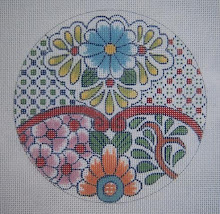 I've had a bit of trouble thinking about "beginner" things to discuss, and just now realized that even the simple techniques of using beads with needlepoint and replicating fabrics does require a good knowledge of and familiarity with basketweave!
I've had a bit of trouble thinking about "beginner" things to discuss, and just now realized that even the simple techniques of using beads with needlepoint and replicating fabrics does require a good knowledge of and familiarity with basketweave! Way back a long time ago, I became fascinated with trying to replicate fabrics in needlepoint, as I was doing a lot of Traditional American quilt patterns on canvas, and wanted to dress up the patches that didn't have "printed" designs on them.
One of my very favorites was dotted swiss, which I had worn a lot as a small child. (My mother loved it.) I still use this from time to time for things like the background of this little cactus, and the blue part of the "beginner" flower in a previous post.
This little barrel cactus canvas (from Sundance) was posted previously (about two years ago) for showing basketweave and outlining properly executed, but I noticed that I also used "dotted swiss" on the background so it wouldn't be so plain. I didn't want to use a textured stitch that would distract from the central design - but it needed something. You can see where I marked little blue dots on the canvas to indicate where to put the "dotted" in the Swiss.
The basketweave around them HAS to be worked first, or they will kind of sink and not stand up so high so as to show up. After doing the background around the dots, simply make an X over the blank tent stitch where you've left the canvas intersection bare. If you make the dots on the intersection where the WARP thread is on top, as a little"bump," it will stand up high and show up well. 

The backside of the little stocking is another example of using basketweave correctly - I usually advocate "design before background" (unless the thread is fuzzy), but have always preferred to stitch the background before the name on a stocking cuff. Several reasons - one is that the fibers from the name, if stitched first, can rub off on the white stitches and make it look "smeared."
This shows the back of one, where I simply carried the thread, doing diagonal work, across underneath where the name is drawn - you can see where I started working the name. It has beads on it, so the blue "Nina" was stitched as I do for inserting beads - basketweave on every other row, using the weft stitches, and leaving the warp bare for the beads. One thing seems to lead to another!
One thing seems to lead to another!
 One thing seems to lead to another!
One thing seems to lead to another! On this front view of the Nina sock, you can see strings of beads with "jewels." I never place the beads clumped up together on a straight line, but leave the warp thread between them. It "reads" well as a straight line of sparkle! In this case, I put Kreinik 002V braid between the beads as part of a chain of jewelry. You can see also that there are beads as well as a tent stitch in the "jewels."
By the way, when placing beads on needlepoint, never place them end to end - especially the faceted ones, as they don't quite fit the space and can look rather strange. The faceted beads aren't perfectly round like the little smooth ones, and appear more like tiny bugle beads - so are too long to be putting end to end. This is just one of the little things one learns with experience and trial and error.
The white patch of Petite Very Velvet is on my December crazy quilt heart - and shows straight lines of clear faceted beads. In this case, as they are on the diagonal, I simply marked lines where I wanted the beads and then worked basketweave around them.
Notice that the beads are NOT placed end to end, as they would have butted against each other and made the lines crooked. They read just as well with the little space between them, as they are lying sideways..

This close-up of one of the coral reef ornaments shows the lines of beads going from the sand up to the top of the sea. The little round, clear beads with the one stitch separating them look just like bubbles, I think. However, I had decided that next time I do this, I'll make the vertical line more irregular with spaces. I used both sizes (#11 and #14) clear beads #250 for this for more "bubble" effect
Next time I'll show where and why to stitch design before background and vice versa. As you can see, one can really start working some amazing but simple effects without having to resort to covering every space on a painted canvas with texured stitches.
This would be overwhelming to a beginner, as one simply cannot just go look in a lot of books and choose stitches at random. This needs to be introduced gradually. After all - we do this for enjoyment and relaxation and to create something fun/beautiful/useful - whatever - for ourselves and our friends and loved ones.


1 comment:
Very clearly explained and demonstrated - it's good to see how you approach these things.
Post a Comment